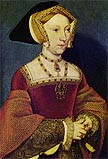
History of the Elizabethan Corset
by Drea Leed
Where did the Corset come from?
Written References to Corsets
Pictures of Corsets
16th c. Corset Construction
Extant Corsets
To Sum Up
Elizabethan Corsets on the Web
Bibliography
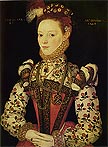
 |
History of the Elizabethan Corsetby Drea Leed
Where did the Corset come from?
|
 |
There are several myths about wearing corsets, many of which spring from Victorian corsetry rather than Elizabethan. In the 16th century, the corset was not meant to draw in the waist and create an hourglass figure; rather, it was designed to mold the torso into a cylindrical shape, and to flatten and raise the bustline. There is one 16th century reference to a small waist being fashionable, but on the whole it was a fashionably flat-torsoed shape, rather than a tiny waist, that the corset was designed to acheive.
Another common myth revolves around the horrible discomfort of corsets. This, too, stems from the tightly-laced waists of the 19th century; the corset worn in Elizabethan England, when fitted and laced correctly, is quite comfortable. Some well-endowed women consider then more comfortable then modern underwire bras, and many people with back problems have remarked how much a boned-tab Elizabethan corset feels like a supportive back brace.
 As the corset was hidden underneath the other layers of dress in the 16th century, finding out about it is difficult. Up to the 1520s, the raised and slightly rounded shape of the fashionable gown could be achieved by a well-fitted kirtle. A German woodcarving of 1520 shows a woman wearing a gown with a definite crease and fold in the fabric under the bust. In Holbein's sketches of the 1520s and his portraits of the 1530s, however, stiffening is definitely required.
As the corset was hidden underneath the other layers of dress in the 16th century, finding out about it is difficult. Up to the 1520s, the raised and slightly rounded shape of the fashionable gown could be achieved by a well-fitted kirtle. A German woodcarving of 1520 shows a woman wearing a gown with a definite crease and fold in the fabric under the bust. In Holbein's sketches of the 1520s and his portraits of the 1530s, however, stiffening is definitely required.
One possible method for creating this flattened bosom is that the Tudor bodices and stomachers were stiffened with buckram (glue-stiffened canvas) to achieve the fashionably flat shape. There is a reference in a Tudor wardrobe account to "buckram for stiffening bodices". Looked at from a practical standpoint, however, it saves time and labor to have one stiffened undergarment to wear under several gowns then to stiffen every gown individually. Having an undergarment to take the strain of shaping the body also helps to extend the life of the outer gown. In addition, tightly-fitted and supportive undergowns worn underneath a decorative outer garments were found through Europe for the entirity of the preceding century; it is only natural that this established trend should have continued.
How did the corset evolve into a separate garment? In the 15th century, a tightly-fitted kirtle worn under the outer gown was used to shape the body into the fashionable form. It's likely that it was the bodice of this kirtle which was first stiffened with buckram, and then with stiffer materials such as reed or bents, as the fashionable silhouette became flatter and flatter during the 1520s and 1530s.
During the 1530s, the decorative skirt of the kirtles worn under gowns underwent a change: instead of an entire decorated underkirtle, a separate, decorated "kirtle" skirt could be worn under the outer gown. instead. When this happened, we can theorize that the by-now-essential stiffened kirtle bodice was retained as a separate garment: the "payre of bodies", or corset as it is now known.
There are also references in early 16th century Spain of a "vasquina" bodice being tied to a farthingale or stiffened skirt. Add stiffening of some kind to this separate under-bodice, and voila--a corset is born.
Written References to Corsets
One problem with finding written references to 16th centuries is that the term "pair of bodies" could denote both a corset and the bodice of a gown. One needs to take the context of the reference into account. If it is a "pair of bodies with sleeves", most likely it is a gown which is being discussed; if materials such as whalebone or bents are mentioned, it could concievably be a corset rather than a bodice. If it is mentioned with petticoats or farthingales, other undergarments of the time, then chances are it is a corset rather than a bodice.
In the 1550s, the first reference to a separate undergarment is found in the wardrobe accounts of Mary Tudor.
Queen Elizabeth had several pairs of bodies listed in her wardrobe accounts. The following listings, according to Janet Arnold (author of Queen Elizabeth's Wardrobe Unlock'd), most likely referred to a corset-like garment.
As we can see, several different materials were used to stiffen bodies: leather, buckram, bents, and, as the 16th century neared its end, whalebone.
In the later 16th century, "French Bodies" was a term commonly used for the stiffened undergarment. In 1577, they were worn in France:
A quote from the late 1590s give us an idea of what they were stiffened with:
Here again a petticoat has a bodie "to" it, indicating that the two were worn--and perhaps even fastened--together.
French bodies show up regularly in tailor's bills of the later 16th century. Here are some listings found in the bills of Tailor's Bills of the 1590s:
Pictures of Corsets
Descriptions are well and good...but what did the period pair of bodies look like? Unfortunately, pickings are slim. As the pair of bodies was an undergarment, it wasn't depicted in period paintings. In fact, I have found only three paintings from the time period which clearly show a pair of boned bodies, all of which date to 1600 or slightly afterward.
 The first is a portrait of Elizabeth Vernon, Countess of Southampton, dated to c. 1600. It shows the countess en deshabille wearing a boned pair of bodies underneath her opened jacket. A very sheer petticoat is attached over the bodies at the waist, showing unboned tabs beneath.
The first is a portrait of Elizabeth Vernon, Countess of Southampton, dated to c. 1600. It shows the countess en deshabille wearing a boned pair of bodies underneath her opened jacket. A very sheer petticoat is attached over the bodies at the waist, showing unboned tabs beneath.
 The second is somewhat later--it dates to the 1620s, but still provides useful information on corsets of the late 16th and early 17th centuries.
"Kitchen interior with the Rich Man and Poor Lazarus", by Pieter Cornelisz van Rijck, shows a kitchen maid dressed in smock, corset, petticoat and apron. The corset has straps which come to a point at the front neckline, where they ostensibly tie to the front of the corset. Like Elizabeth Vernon's corset, this one is also very flat, laces up the front, and is boned with narrow, vertical channels.
The second is somewhat later--it dates to the 1620s, but still provides useful information on corsets of the late 16th and early 17th centuries.
"Kitchen interior with the Rich Man and Poor Lazarus", by Pieter Cornelisz van Rijck, shows a kitchen maid dressed in smock, corset, petticoat and apron. The corset has straps which come to a point at the front neckline, where they ostensibly tie to the front of the corset. Like Elizabeth Vernon's corset, this one is also very flat, laces up the front, and is boned with narrow, vertical channels.
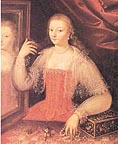 Another picture, "Woman at her Toilet", was painted by a member of the French School of the 17th century and is dated to the beginning of the 1600s. It is currently at the Musee Ingres, and a picture can be found in Anne Kraatz's book Lace: History and Fashion.
Another picture, "Woman at her Toilet", was painted by a member of the French School of the 17th century and is dated to the beginning of the 1600s. It is currently at the Musee Ingres, and a picture can be found in Anne Kraatz's book Lace: History and Fashion.
This woman is depicted wearing her petticoat with stays worn over it, something seen in later 17th century paintings. Although this painting does not clearly show the boning ridges (this may be due to a decorative covering to the stays or to the quality of the picture), the angle of the tabs indicate that they are stiffened in some way. The straps of the corset are visible beneath the sheer cape worn by the woman to protect her clothing while dressing her hair.
Extant Corsets
Fortunately, we have more to go on than paintings. There are currently two known corsets from the 16th century, and two stomachers dated to the early 17th century, which we can look at as examples.
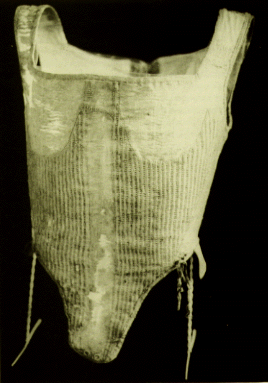 The first and best known example of a 16th century corset is the German pair of bodies buried with Pfaltzgrafin Dorothea Sabine von Neuberg in 1598. This corset is shown in detail on page 47 and 112-113 of Janet Arnold's Patterns of Fashion 1560-1620 and in Jutta Zander-Seidel's book Textiler Hausrat. It is made of three layers of cream-colored fabric, the outer layer being silk backed with linen and the inner lining of linen, and has channelsbackstitched between the two layers into which whalebone was inserted. It has tabs at the waist, as well as small eyelets at the waistline through which the farthingale (stiffened hoop skirt) or petticoat could be fastened to the corset.
The first and best known example of a 16th century corset is the German pair of bodies buried with Pfaltzgrafin Dorothea Sabine von Neuberg in 1598. This corset is shown in detail on page 47 and 112-113 of Janet Arnold's Patterns of Fashion 1560-1620 and in Jutta Zander-Seidel's book Textiler Hausrat. It is made of three layers of cream-colored fabric, the outer layer being silk backed with linen and the inner lining of linen, and has channelsbackstitched between the two layers into which whalebone was inserted. It has tabs at the waist, as well as small eyelets at the waistline through which the farthingale (stiffened hoop skirt) or petticoat could be fastened to the corset.
A pocket sewn down the front of the German corset allowed a stiff busk to be slipped into the corset, to provide a completely flat front. The armholes are rather far back, as are the armholes of most garments of the time; a stiff, upright, and what modern people would call unnaturally rigid posture was considered a mark of good breeding.
This was a German corset, and therefore cannot be considered an example of English Elizabethan fashion; nevertheless, it is the earliest surviving corset we have.
The busk which would have been slipped into the busk pocket, was a long, flat piece of ivory, horn or wood, elaborately carved in later centuries, which helped to give a pair of bodies a rigid, smooth shape. In 1579, Henry Etienne mentioned this item in a letter: "The ladies call a whalebone... their stay, which they put under their breast, right in the middle, in order to keep straighter." This stay, or busk, could be tied into place by a busk-lace to keep it from shifting up or down. The busk-lace eventually became an intimate favor, given by women to the men they loved.
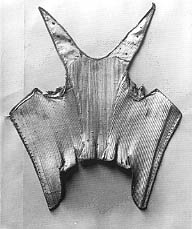 The second corset is English, and was put on the effigy of Queen Elizabeth in 1602. It currently resides in Westminster Abbey, along with a detailed write-up of the corset by Janet Arnold which is kept in the Westminster Library. There is a photograph of this corset in Norah Waugh's book Corsets and Crinolines.
The second corset is English, and was put on the effigy of Queen Elizabeth in 1602. It currently resides in Westminster Abbey, along with a detailed write-up of the corset by Janet Arnold which is kept in the Westminster Library. There is a photograph of this corset in Norah Waugh's book Corsets and Crinolines.
This corset was also stiffened with whalebone. Unlike the German corset it had boned tabs and a wide, scooped neck which hinted at the shape the corset would attain during the next two centuries. It laces up the front. Interestingly, the front edged of this corset curves in below the bust and out over the bust. Due to the front lacings, it has no busk;instead, two heavy strips of whalebone run down either side of the front lacing. You can find out more about the Effigy corset in the article "The Effigy Corset: A new look at Elizabethan Corsetry."
Aside from these two items, all we have are two 17th century stomachers, one currently in the Globe Theatre in London and the other in the Rocamora Collection of Barcelona, which were both cut down from corsets. They are virtually identical in proportion and construction; both are made of a heavy, coarse linen, are boned with thin reeds, and are braced with horizontal crossbraces of whalebone down either side of the front center lacings.
Corset Construction
Based on the extant corsets we have to examine and on the construction techniques found in other garments of the period, we can draw some conclusions about how these items were made in the 16th century.
Professional tailors often mention corsets in their bills and accounts. Like French Farthingales, petticoats and kirtles, "whaleboned bodies" were an item readily available from a lady's tailor. As with many other garments of the time, women who couldn't afford a tailor could easily make a corset at home from sackcloth and the small reeds readily available to all for stiffening.
The effigy corset was made of three pieces--two front pieces and one back piece--which were made and finished separately and whip-stitched together along the side back seams before wearing. This technique would allow for easier size changes: if the wearer gained or lost weight, the back could be removed and a smaller or larger piece added.
These corsets and the two stomachers were constructed by placing layers right sides out, sewing the boning channels, and then binding the edges with a strip of leather or fabric. The modern "sew right sides together and then turn right sides out" was an uncommon technique of the time.
The binding on the two corsets and on two extant stomachers of the time was placed right side against the outside edge of the corset, stitched down, turned over to the wrong side, and either hem-stitched down along the edge or stab-stitched through to the front of the corset, following the seam line of the outer binding edge. In the case of the two stomachers, the raw edge was left unfinished on the inside. Binding strips could be made of ribbon, of fabric cut on the bias, or of fabric cut on the straight.
The boning channels on the Pfaltzgrafin's corset and two 17th century stomachers were backstitched, which would add strength and flexibility to the seams as well as adding a more finished look. The seams on the effigy corset were stitched with a running stitch.
Lacing holes had a row of boning to either side of the holes, in all cases. The holes were poked with an awl and whipstitched around the opening for strength.
In all pictures and extant corsets and stomachers, the boning runs straight up and down across the entire front.
The quality of material varied widely, as can be seen from the different listings for corsets: sackcloth for less exalted bodies and for lining more expensive pairs of bodies which were covered with damask, satin or taffeta. The quality of construction varied as well. On one of the stomachers, there were four backstitches per inch; the Pfaltzgrafin's corset was made with smaller stitches and finer thread, as was the Effigy corset.
To sum up
During the 16th century, corsets were made out of linen, linen-cotton blends (after 1570), or, in the case of nobility, an outer layer of leather, satin or other silk and inner layers of linen. Whalebone, horn and reeds were the most commonly used materials for stiffening the pair of bodies, although heavy corded rope cannot be discounted as a possibility. The boning was slipped into channels between the outer and inner layers of the corset, which could be either running-stitched or back-stitched. Corsets could lace at the center front or center back, through eyelets reinforced with a buttonhole or whip stitch. A corset could have unboned tabs at the waist, a ruffle of fabric sewn at the waist, or boning extending down into the tabs. It could even be fastened to a petticoat or farthingale, either tied to it with points (laces run through eyelets) or perhaps sewn.
From practical experience, the boned-tab corset is immeasurably more comfortable than a corset with no tabs or unboned tabs. The straps of the Effigy corset are also more comfortable than those of the Pfaltzgrafin corset, as they don't cut into the armhole as much and are cut on the bias. For the ramrod-straight court gown, a back-lacing corset with a busk is required. For more informal gowns, or gowns without a deep point in the front, a front-lacing corset is fine. Front lacing corsets are more comfortable and easier to get into, although it's a good idea to have back lacing for adjustment. Lacing the farthingale to the corset eliminates shifting, makes the whole garment move better and is more comfortable (in my opinion). A petticoat with a heavily boned bodice is a convenient alternative to a separate corset and skirt. It eliminates bulk at the waist, as well.
Want to learn more? Check out:
| Home |
Alcega, Juan de. Tailor's Pattern Book 1589.
Anderson, Ruth. Hispanic Costume 1480-1520
Anonymous. Il Libro del Sarto (the Book of the Tailor), c. 1570
Anonymous. The Tailor's book of Enns, Lipperheide Museum, Berlin. c. 1590
Arnold, Janet. Queen Elizabeth's Wardrobe Unlock'd.
Arnold, Janet. Patterns of Fashion: The Cut and Construction of Men and Women's Clothing 1560-1620
Arnold, Janet. "Stays or Corset". A summary of findings on the pair of stays worn by the effigy of Queen Elizabeth. Westminster Library, London.
Ashelford, Jane. A Visual History of Costume: the 16th Century.
Buck, Anne. "The Clothes of Thomasine Petre,1555-1559", Costume Vol 24 (1990)
Bestetti, Carlo. Abbigliamento e Costume nella Pittura Italiana (vol 1: Rinascimento)
Carter, Alison. "Mary Tudor's Wardrobe", Costume Vol 18 (1984)
Cunnington, P. Handbook of Costume in the 16th century
Hunnisett, Jean. Period Costume for Stage and Screen
Ilid, Anthony. "Clothing Given to a Late Sixteenth-Century Servant in Wales", Costume Vol 14 (1980)
Linthicum, M. Channing. Costume in the Drama of Shakespeare and his Contemporaries
Elizabethan Pageantry
Stern, Elizabeth. "Peckover and Gallyard, Two Sixteenth Century Norfolk Tailors" . Costume Vol 15 (1981)
Scott, Margaret. Gothic Europe 1400-1500. History of Dress series
Staniland, Kay. "The Medieval 'Corset'", Costume Vol 3 (1969)
Waugh, Norah. Corsets and Crinolines
Zander-seidel, Jutta. Textiler Hausrat